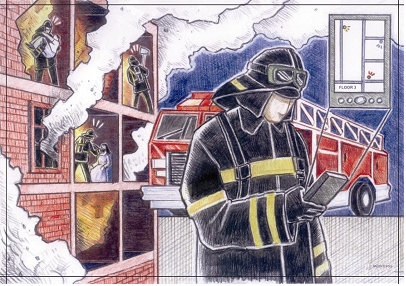| * |
|
Ultra-Wideband Location
Summary:This page provides a summary of the testing and evaluation conducted at NIST on Ultra-Wideband (UWB) location systems for first responders. Description:Indoor location proves particularly challenging due to the small dimensions of the environment typically fraught with numerous walls and furniture between base and mobile stations. These dimensions translate to wireless communication links with severe multipath fading. The latter in turn inhibits the reliable isolation of the direct path in the received signal, degrading performance. This project deals with characterizing the physical limits that multipath fading incurs on location systems. To this end, we assembled Ultra-Wideband channel sounders to gauge these limits. We then conducted extensive measurement campaigns in four buildings with diverse construction materials throughout in both line-of-sight and non line-of-sight conditions. The location performance has been documented according to the system parameters of center frequency and bandwidth. Major Accomplishments:Range estimation in backboned location systems Ultra-Wideband signals are characterized by a bandwidth greater than 500 MHz or one exceeding 20% of the center frequency of radiation. Such technology shows promise for indoor ranging due to its fine time resolution to resolve multipath fading and the presence of lower frequencies in the baseband to penetrate walls. Emergency response systems in particular require that mobile rescue devices inside a building maintain connectivity to at least three base stations deployed outside to estimate their locations through triangulation of ranges. In principle boosting transmission power to levels above the FCC mask can ensure such connectivity for large buildings, however connectivity alone cannot guarantee precision due to the distorting effects of walls (and other objects) in the direct path. The number of wall interactions in general increases with range, leading to a degradation in performance due to the physical limits of the system. We carried out 5000 measurements in the frequency domain from 2-8 GHz throughout four separate buildings and reported the ranging performance based on time-of-flight estimation. Specifically, we studied of the relationship between range error and:
Location systems with ranging capabilities alone necessitate at least three base stations with known locations to extract the two-dimensional position of an unknown device through triangulation. In emergency operations such as fire rescue, no such infrastructure exists to date as part of the building code, nor does time permit installation as a crisis unravels. However if both the range and angle of the device were known, then a single base station alone could extract its location. Moreover if the base station itself were a mobile device attached to a fireman, then the system could be used to find trapped victims equipped with beacon tags, yielding their locations with respect to the fireman as he moves about. Bearing systems alone lack any notion of time and in general select the strongest arrival which is rarely the first one in non line-of-sight conditions. Complementing UWB ranging systems with bearing capabilities allows indexing the arrivals as a function of both time and angle in order to isolate the first, providing precision range and angle. Analogous to our comprehensive evaluation of the time-of-flight for UWB ranging, we extend the measurement suite to include angle-of-flight as well, and show its performance according to variation in system parameters. The channel propagation measurements gathered in the suite are available for download at NIST UWB-MIMO Channel Propagation Measurements in the 2-8 GHz Spectrum. |
 End Date:ongoingLead Organizational Unit:ITLContact
General information:
301-975-3685 Telephone
100 Bureau Drive, M/S 8920 Gaithersburg, MD 20899
|
